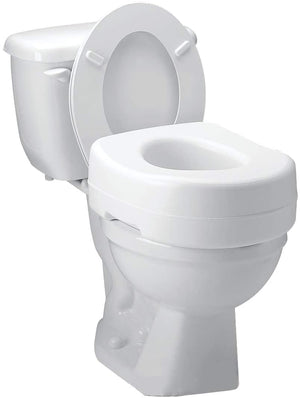Do you have a raised toilet seat?
You might have a toilet riser, or one of the newer elongated toilets that have been marketed to the elderly. As the United States' aging population has risen, so have our toilet seats. These extra tall toilets make it so we don't have to squat down as far to use the toilet, which can be a blessing for those who have a harder time getting up.
But is your raised toilet good for you overall? Let's take a look at the pros and cons of the raised toilet seat.
Raised Toilet Seat Pros
1. They make getting up easier.
A raised toilet seat means that once you're sitting down, you have less distance to travel to get up again. This means if you have atrophied muscles, or bad hips or knees, or arthritis, you might be able to get up easier with a raised toilet seat. Those extra five inches might be the difference between you maintaining your independence, or having to call someone for help getting up from the toilet.
2. You may avoid a slip and fall accident.
Studies show that that 33% of adults over 65 will have at least one fall per year. And up to 80% of falls occur in the bathroom. Again, having your legs at less of an angle at the knee joint might give you the extra boost you need to avoid falling as you stand up.
3. You'll experience less pressure on your joints.
Those with arthritis know to avoid any unnecessary bending of the joints, as it can increase pain. Keeping your legs bent at less of an angle due to the height of your toilet seat may help you reduce pressure on your joints.

Raised Toilet Seat Cons
1. A raised toilet seat increases constipation.
It isn't talked about often, but squatting is the best position for passing stool. When we squat our pelvic floor muscles relax, making it easier to have a bowel movement. Now, we realize a full squat isn't an option for most seniors! But having our knees bent at less than a 90 degree angle closes off the pelvic floor and makes pooping harder.
How many of you are on medicines for constipation, like Amitiza or Linzess? An older gentleman I know was put on this medication after installing raised toilets in his home. Medications for constipation can cause unpleasant side effects. This means an extra-tall toilet can set off a domino effect of health problems, especially over time.
2. For shorter folks, your feet might dangle, which can cause instability.
Anything that causes more instability could mean a fall while getting up. In effect, you'll be jumping down from the toilet, while attempting to stand at the same time. This is a recipe for a fall.
3. Raised toilet seats don't gently and slowly raise you from a seated position, the way an electric toilet lift does.
Even if your toilet seat is raised, you will still need to rely on the muscles of your legs and the health of your joints to stand up. A few extra inches may help, but will not guarantee a safe dismount from the toilet.
An electric toilet lift like the Dignity Lifts toilet lift you slowly, providing you with an extra 14 inches of height as it straightens your legs and gently propels you to standing.
We hope you found this article useful as you decide what kind of toilet and accessories are right for you or your loved ones. Please share it with your friends, or join our newsletter for free shipping on your Dignity Lift.

